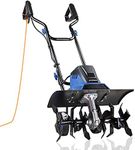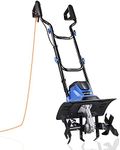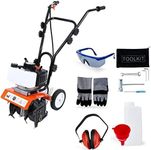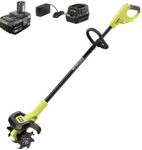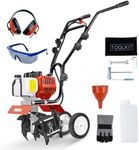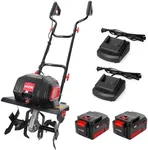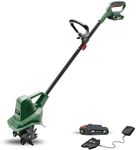Buying Guide for the Best Garden Tillers
Choosing the right garden tiller can make a significant difference in the ease and efficiency of preparing your garden soil. Garden tillers are essential tools for breaking up hard ground, mixing in compost, and preparing the soil for planting. To find the best fit for your needs, it's important to understand the key specifications and how they relate to your gardening tasks. Here are the main factors to consider when selecting a garden tiller.Tiller TypeThere are three main types of garden tillers: front-tine, rear-tine, and mini-cultivators. Front-tine tillers are versatile and suitable for medium-sized gardens; they are good for both breaking new ground and cultivating. Rear-tine tillers are more powerful and better for larger gardens or tougher soil conditions. Mini-cultivators are lightweight and ideal for small gardens or raised beds. Choose the type based on the size of your garden and the condition of your soil.
Engine PowerEngine power, measured in horsepower (HP) or cubic centimeters (cc), determines the tiller's ability to break through tough soil. Higher power engines (5 HP or more) are suitable for large gardens and hard, compacted soil. Medium power engines (3-5 HP) are good for average-sized gardens with moderately tough soil. Lower power engines (under 3 HP) are best for small gardens with loose soil. Match the engine power to the size of your garden and the difficulty of the soil you need to till.
Tilling WidthTilling width refers to the width of the soil that the tiller can work in a single pass. Wider tilling widths (20 inches or more) are efficient for large gardens, reducing the number of passes needed. Medium widths (12-20 inches) are suitable for average-sized gardens, offering a balance between maneuverability and efficiency. Narrow widths (under 12 inches) are ideal for small gardens or tight spaces. Consider the size of your garden and how much space you need to navigate when choosing the tilling width.
Tilling DepthTilling depth indicates how deep the tiller can dig into the soil. Deeper tilling depths (8 inches or more) are necessary for breaking new ground or preparing soil for deep-rooted plants. Medium depths (4-8 inches) are suitable for general garden preparation and mixing in compost. Shallow depths (under 4 inches) are best for light cultivation and weeding. Determine the depth you need based on the type of gardening you plan to do and the condition of your soil.
Weight and ManeuverabilityThe weight of the tiller affects how easy it is to handle and transport. Heavier tillers (over 100 pounds) provide more stability and are better for tough soil but can be harder to maneuver. Medium-weight tillers (50-100 pounds) offer a balance between stability and ease of use. Lightweight tillers (under 50 pounds) are easy to maneuver and transport but may struggle with hard soil. Consider your physical strength and the terrain of your garden when choosing the weight of your tiller.
Additional FeaturesAdditional features such as adjustable handles, counter-rotating tines, and electric start can enhance the usability and comfort of the tiller. Adjustable handles allow for better ergonomics, counter-rotating tines improve soil mixing, and electric start makes starting the tiller easier. Think about which features will make your gardening tasks more comfortable and efficient, and choose a tiller that includes those features.
